How to Grow Tasty Citrus Outside in Zone 7+ (Tangerines, Grapefruit, Oranges, & More)
On Friday, February 25th we left our Appalachian foothills home at 9:30am and drove to a nursery that grows tangerines, satsuma mandarins, naval oranges, kumquats, grapefruits, and other citrus in an outdoor orchard. No, not Florida! Even after touring the nursery for over an hour, stopping for lunch, driving slowly through heavy thunderstorms, and navigating rush-hour traffic, we still made it home again by 6:30pm.
McKenzie Farms is in Scranton, SC and is rated USDA zone 8a. Citrus can be grown outdoors in zone 7 (with protection) and up.
(Gardeners in colder zones can try trifoliate oranges or growing citrus in pots.)

Photo Caption: McKenzie Farms offers various fruit trees (including hardy citrus), ornamentals, and South Carolina certified produce.
Stan McKenzie says he planted his first South Carolina citrus as a young boy. When the plants died, he gave up for a while.
As an adult, he was satisfied growing a Meyer lemon indoors until he encountered truly outdoor grapefruits in Charleston, SC.
At that point Stan began experimenting with different varieties, trying multiple growing methods, and collaborating with other gardeners. Eventually, he proved to himself that cold-hardy citrus is no myth. Yes, you really can grow citrus trees in the ground outdoors in zone 7 and up. Yes, you can grow varieties of tangerines, mandarins, oranges, grapefruits, kumquats, and more. Yes, most of it really does taste good.
I haven’t tasted them yet but I believe Stan when he says they’re as good as the fruit sold at the store. His customers swear by them, too. There was a couple browsing the nursery who assured us the fruit harvested from Stan’s orchard is so delightful that they bought bushels of it last season.
The catch is that it isn’t maintenance-free. If you want to establish some fruit in your yard and forget about it, get blueberries. But if you love citrus and don’t mind growing outside-the-box, try the proven varieties sold at the McKenzie nursery.
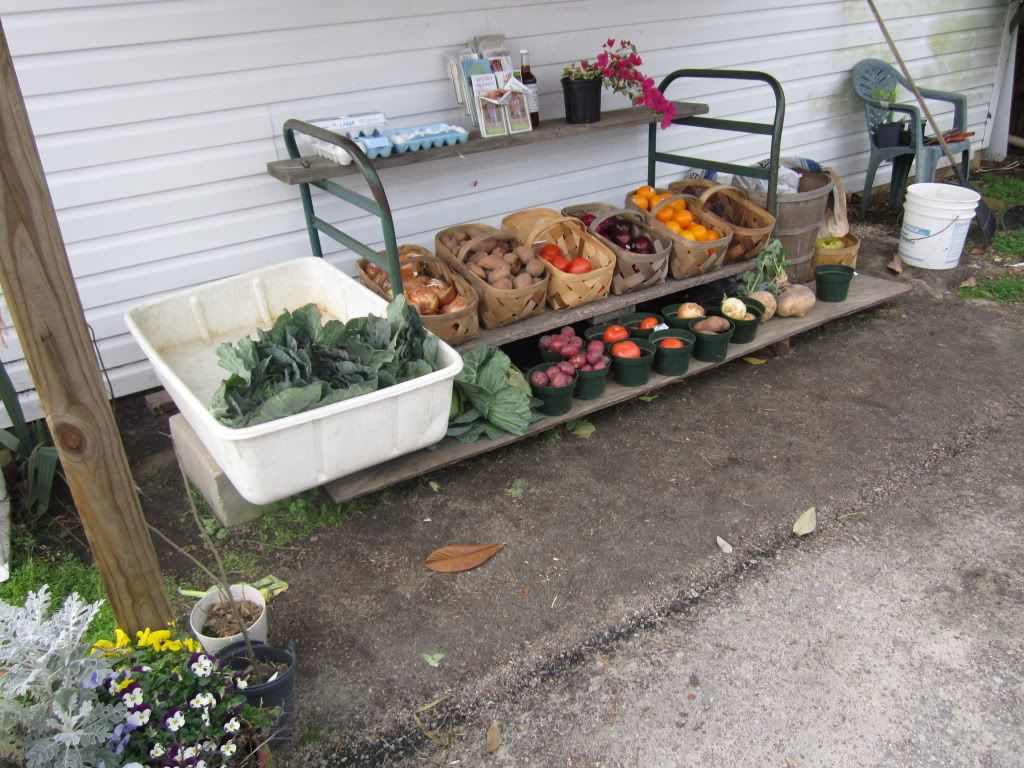
Photo Caption: Visitors to McKenzie Farms include citrus aficionados who have driven hours to see his hardy orchard; yet some neighbors within a 6-mile radius have no idea he's growing tangerines in their vicinity. Many of his regular customers come to purchase produce from the farm.
So what are you getting yourself into? Don’t worry, it’s not much more effort than regular garden chores and you have a few options.
The easiest is to choose a microclimate when siting your citrus. For a small number of trees, Stan recommends planting them close to a south or east facing wall. This protects the trees from cold winds and many buildings also absorb and then radiate heat during the night. Even a few degrees can make all the difference.
Still, Stan says young trees (4 years old or less) just aren’t that hardy yet. He likens citrus saplings to infants in need of extra assistance to reach adulthood. Plus, even if your trees have fully matured, you’ll probably still have to provide some protection at least part of the winter in zones 7 and 8. The good news is that there are many reliable ways to keep your citrus from suffering at the whim of Mother Nature.
Stan’s extensive orchard is proof enough, but while driving home we actually saw wild citrus trees completely unprotected along the roadside. No telling how the fruit of those renegades taste, though.
How much you have to baby your trees depends on the variety you choose. Unsurprisingly, the tastier varieties tend to demand more attention.
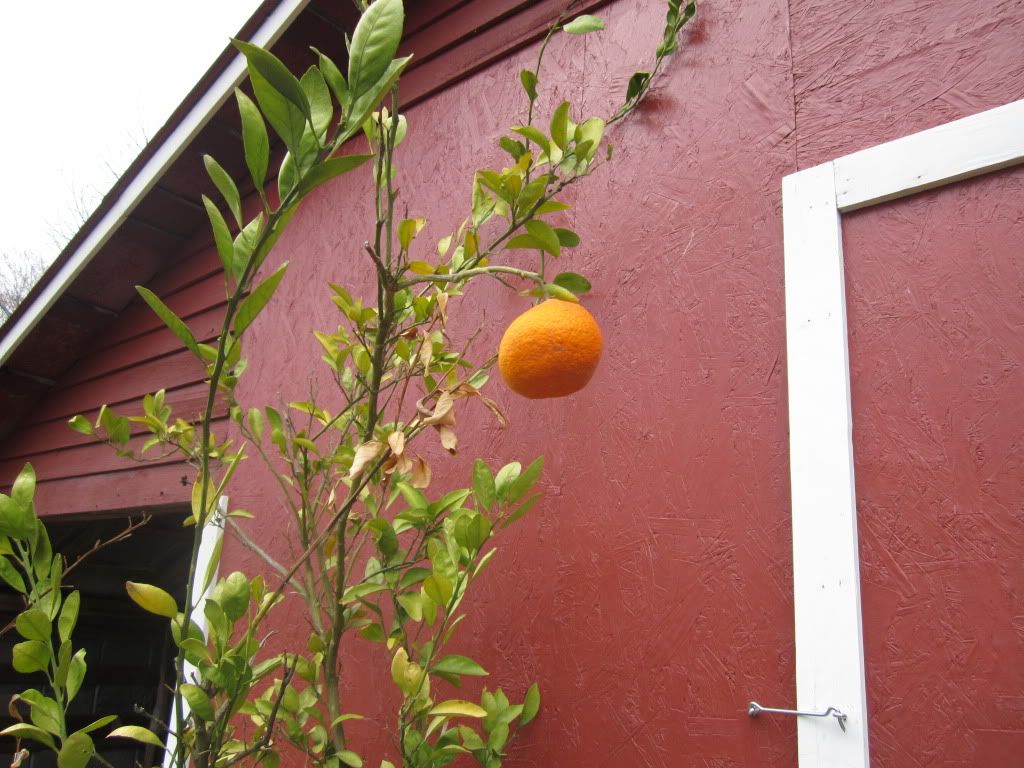
Photo Caption: We think this was the perfect time to visit because we got to see how Stan protects the trees from cold weather. You'll need to go in November if you want to see (or taste) lots of fruit. This tangerine was still hanging on next to its barn wall microclimate, but most of the orchard was picked clean.
If you want to grow a large orchard out in the open like Stan’s, a good option is to invest in a reliable sprinkler system. Surprisingly, the hardier varieties of mandarins and tangerines can be protected by a thin coating of ice! Stan’s trees don’t mind a consistent temperature of 32 °F and ice can make that happen even if the air temperature gets much lower. The sprinklers should be turned on before temperatures reach 30 °F.
Stan says it is important to keep trees pruned if you plan to use this method. That way fewer branches break from the weight of the ice.
Some people also have luck by wrapping their trees in Christmas lights. Lighted trees stay warmer, but the protection can be improved by covering the lighted tree with a blanket or plastic sheet. Note that all forms of cover should be ventilated or removed when the weather warms up again or the tree can cook. Tree lights should be removed and reapplied once a year to keep them from girdling the trunk.
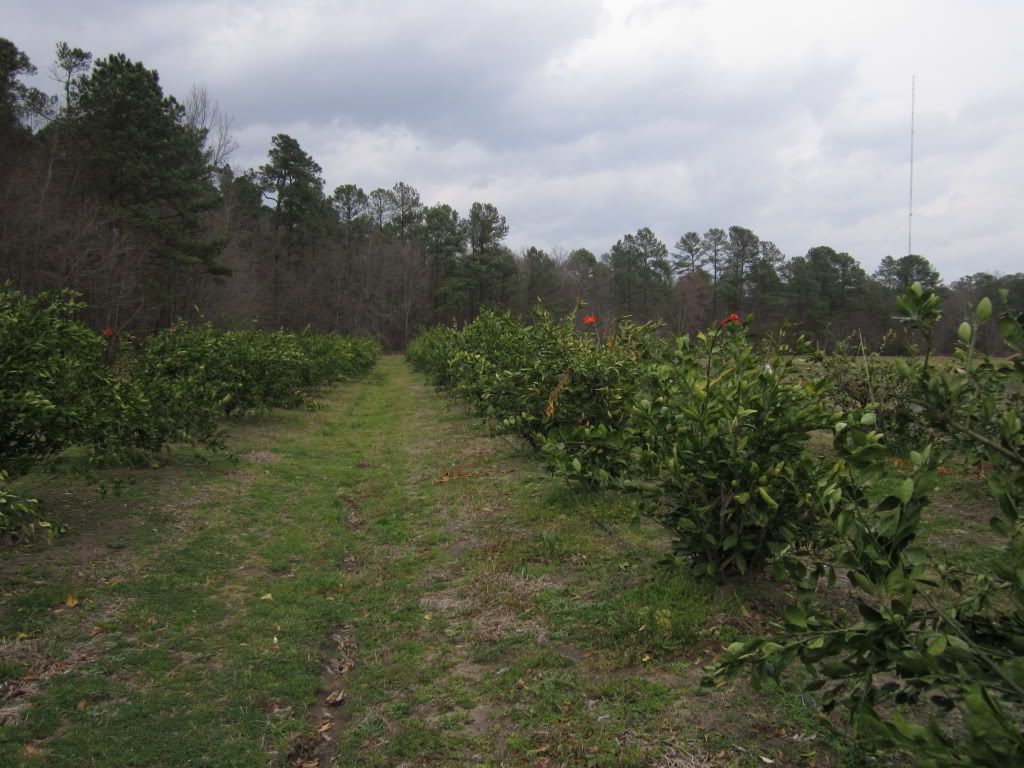
Photo Caption: Rows of fully outdoor citrus in the McKenzie Farms orchard. Each tree's canopy is outfitted with a mini-sprinkler head used to protect the plant during inclement weather. This makes it possible to harvest bushels of tangerines and mandarins in November.
The last option takes a little more labor but offers the most security. Stan builds simple wooden frames around less hardy varieties like naval oranges and grapefruits. When cold weather arrives, he attaches light-permeable greenhouse plastic film to the sides of the frame and puts black water barrels inside to absorb and radiate passive solar heat. It must work — yesterday these trees were blooming so profusely inside their tents that I could smell the orange blossom fragrance over 100 yards away! He says he also sprays the tented trees with water or runs a small electric heater on an extension cord when temperatures hit rare, brutal extremes.
Some links on citrus care in the cold:
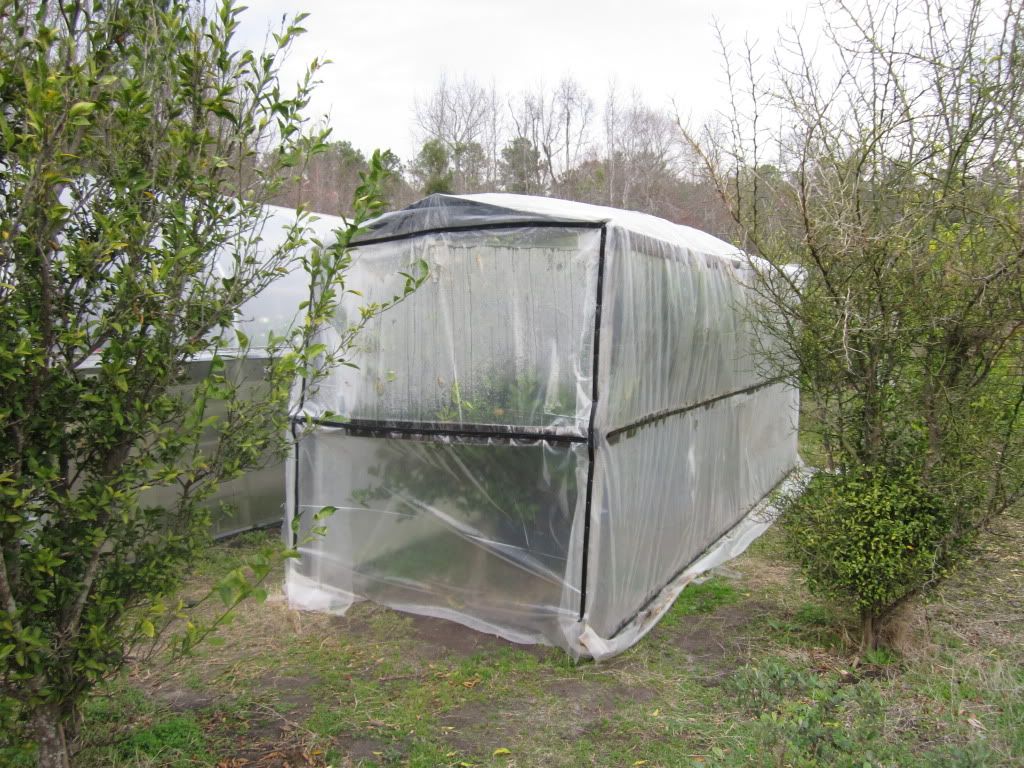
Photo Caption: Although the most tender citrus (such as Meyer lemons) require a heated greenhouse for winter protection, Stan has found varieties of grapefruits and naval oranges that are able to be grown with simple, passive solar protected enclosures. Stan says that one of his winter-covered trees produced over 100 delicious grapefruit last season.
In addition to winter protection your citrus will thank you for well-drained, fertile soil and consistent water. Full sun, a long season (which can be obtained through covering trees), and warm summers are also required for best results.
For pollination, wild bees are likely to be attracted to your trees. Stan goes a step further and allows a beekeeper to maintain honeybees on his property. He may be the only South Carolinian currently enjoying his own orange blossom honey!
Fertilization needs will vary on your local soil but in general, citrus are considered heavy feeders. Most websites recommend high nitrogen fertilizers, though Stan says a 5-10-10 blend with micronutrients works well for him. He says to follow the package instructions and start fertilizing as soon as the danger of frost passes in the spring. He stops applying fertilizer by August 1st to slow new growth and give the trees time to harden off for winter.
Here are some links on citrus nutrient needs that may be applicable for your area:
- Citrus fertilizing chart from University of Florida Cooperative Extension (.pdf)
- Citrus fertilizing chart from University of Arizona Cooperative Extension (.pdf)
- Article and chart on citrus fertilization from Texas Agrilife Extension
- Fertilizing citrus @ Four Winds Growers
- Growmore pre-packaged organic citrus fertilizer from Logees Nursery
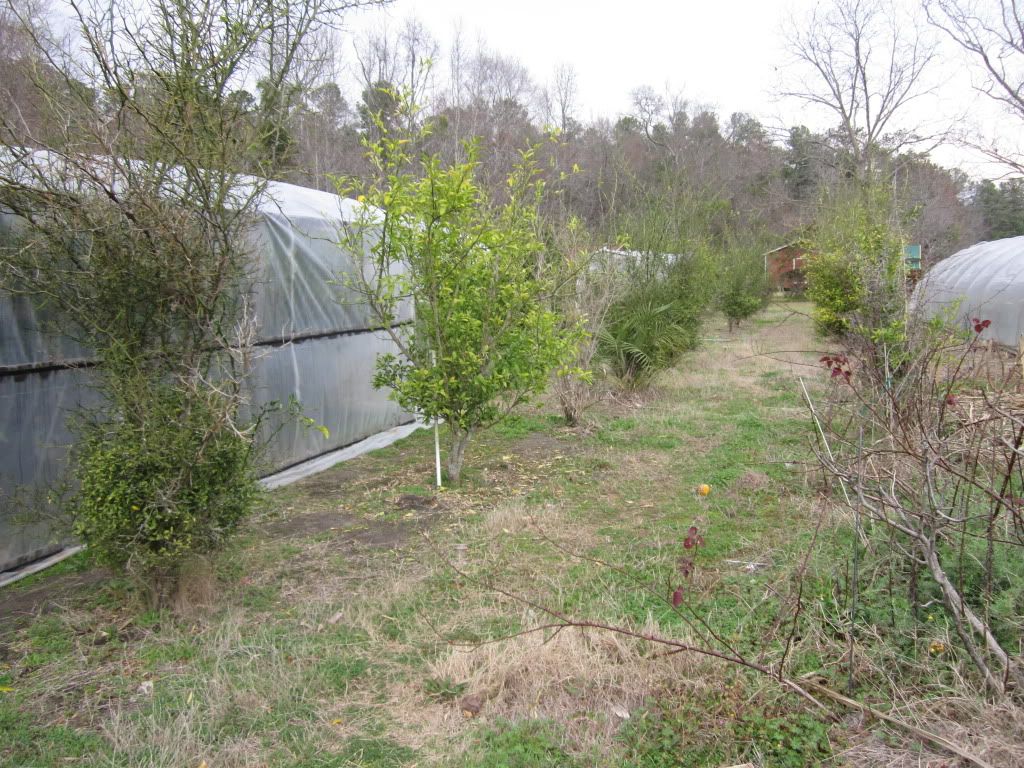
Photo Caption: Stan plants hardier citrus along the outside of his enclosed trees to take advantage of the microclimate they create. Both types of tree quickly bounce back from winter woes when temperatures rise in the spring.
If hardy citrus is a dream of yours, don’t give up! Experimenting until you find a method that works for you can be very rewarding. Some of the trees at McKenzie farms are 20 years old and still cropping heavily!
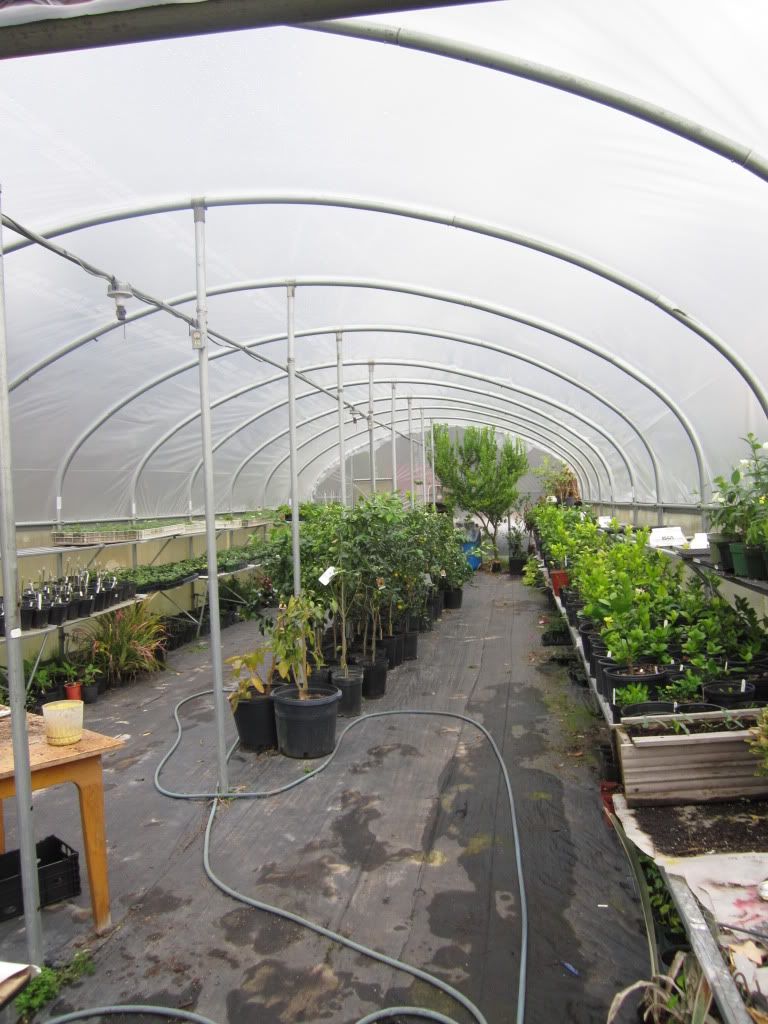
Photo Caption: The grafting and growing out of nursery stock is done in two large greenhouses, complete with insect-munching Carolina anole lizards.
McKenzie Farms is the northernmost citrus orchard on the east coast. Stan grafts from trees that have survived freak freezes in commercial citrus growing areas as well as reputedly cold hardy varieties from all over the world. A lot of the specimens he offers are rare and hard to find.
We felt much more comfortable with our home project after visiting the farm. If you’re a visual learner you can’t go wrong asking Stan for a tour, but check with him through phone or email to make sure it is a good time. You can’t find a grower more experienced with pushing the citrus envelope.
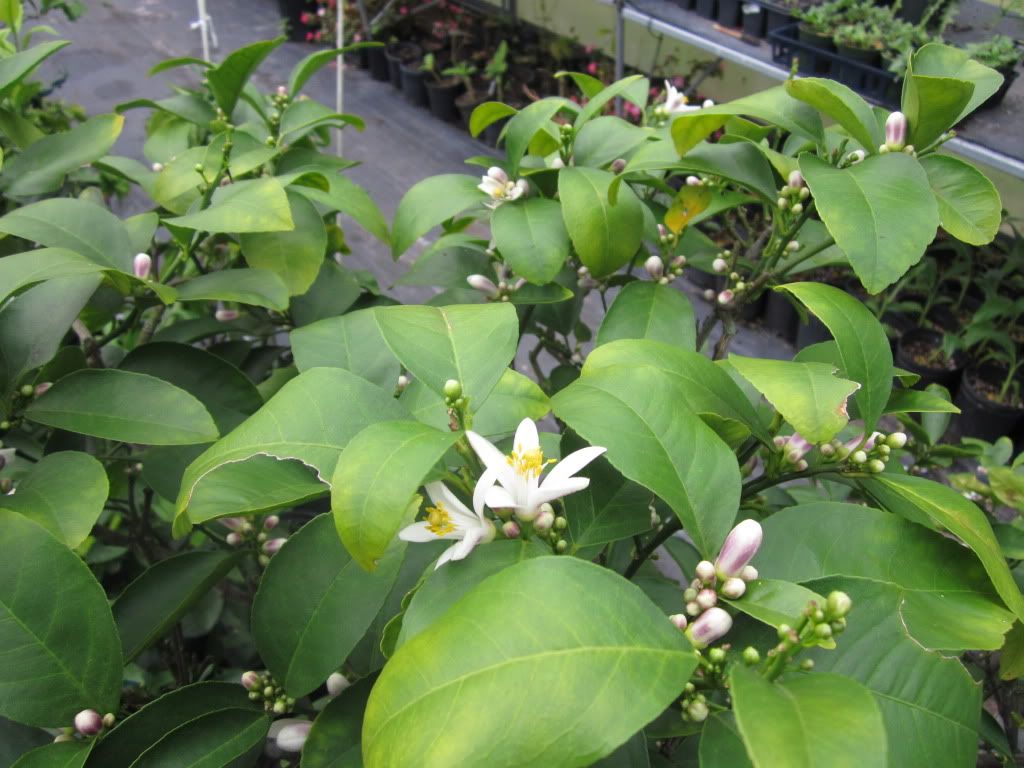
Photo Caption: If only photos could smell! At 40 years old, Stan's-heavily blooming Meyer lemon is the oldest tree in his collection. Lemons are among the most tender citrus species, so this wizened tree retires to the warm greenhouse all winter.
Our drive home involved excited plans to build our passive solar citrus “cave” as a dual cold frame for our spring transplants. It will be mostly inconspicuous next to the shed in our driveway, and we’ll be delighted to keep all the winter seed trays out of the kitchen.
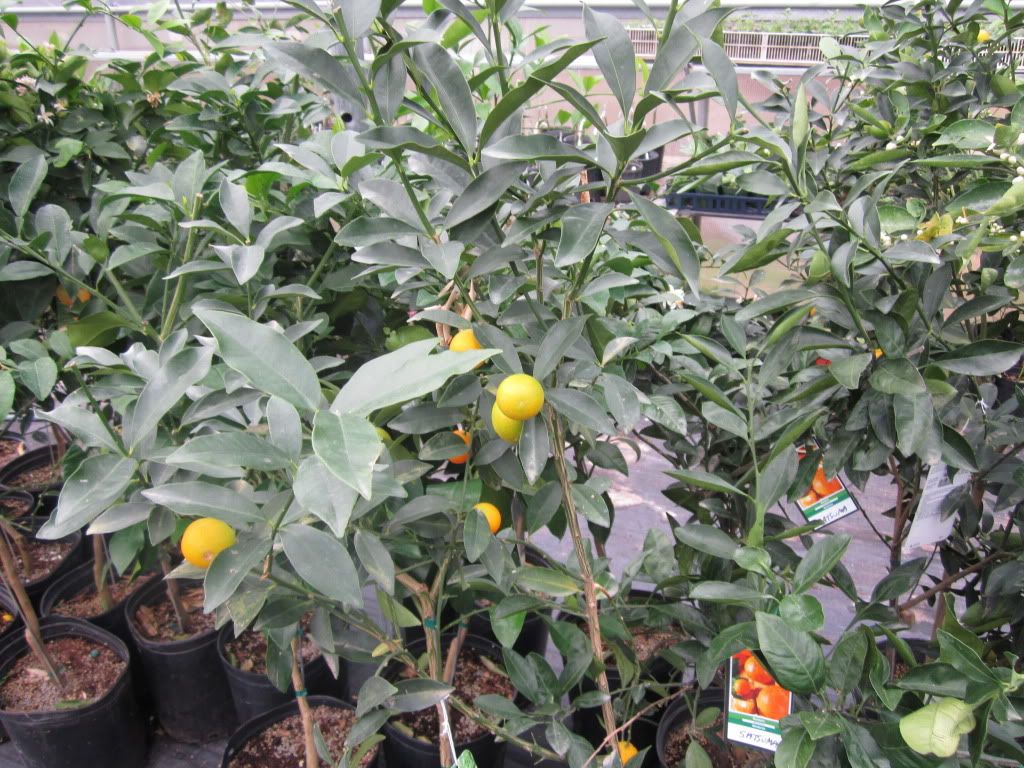
Photo Caption: These round 'Meiwa' kumquats are reputedly sweeter than the 'Nagami' kumquats we bought, but they are less successful as marmalades and jam.
Of course we didn’t come home empty-handed!
Our new backyard citrus orchard is comprised of a ‘Seedless Nagami’ kumquat, an ‘Owari’ satsuma, and a ‘Thomasville’ citrangequat. The unripe citrangequat fruits are supposed to work well as a lime substitute. Plus, think of all the food miles I’ll avoid by picking my own Christmas kumquats and satsumas!
Unsurprisingly, we also experienced a few impulse buys — two loquat seedlings and another pineapple guava to go with the pair we already own. They’ll likely end up in their own post sooner or later.

Photo Caption: We're hoping the cats will ignore our new fruit tree collection as it perches indoors for the remainder of the winter.
I didn’t think our visit to McKenzie Farms could get any better, but then Stan recommended The Shrimper for lunch. What a bonus! Only a few miles up the road in Lake City, we’re happy to recommend it in the category of regional restaurants that do what they do well.
You won’t find them serving locally grown citrus (I think the only produce on the menu was cole slaw). What you will find is authentic fresh-catch seafood served with hush puppies and sweet tea.
Yum!
For those of you who get serious about hardy citrus, you may also enjoy the following resources:
- Hardy Citrus for the Southeast by Tom McClendon, also available through McKenzie Farms
- The Southeastern Citrus Expo linked here and written up here
- The Citrus Growers Forum
- The citrus forum @ GardenWeb.com
- Stan McKenzie’s recommended links
26 thoughts on “How to Grow Tasty Citrus Outside in Zone 7+ (Tangerines, Grapefruit, Oranges, & More)”
Comments are closed.
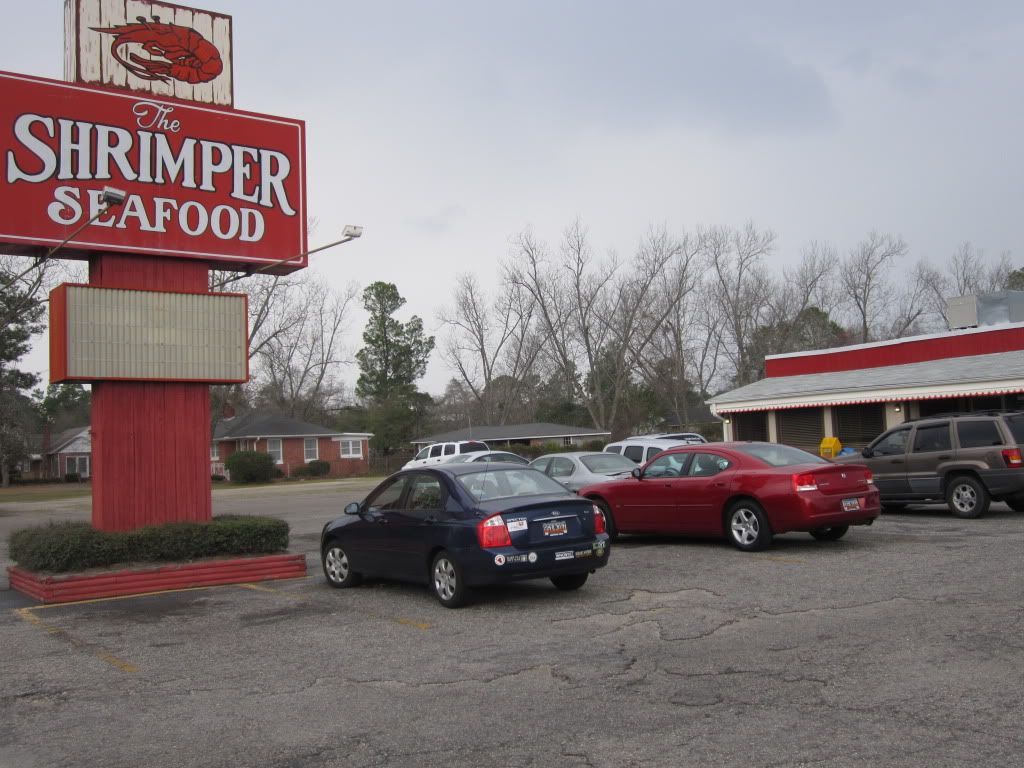

Janet, The Queen of Seaford - February 25, 2012 9:23 pm
Growing Citrus sounds like a bit of TLC. I love the fragrance of the citrus blooms. Used to have a Meyer lemon…ohhhh the scent!
Janet, The Queen of Seaford´s last blog post ..Walking With The Queen and Friends
Sustainahillbilly
Twitter: appalachianfeet
- February 26, 2012 11:59 pm
Definitely requires some TLC… but I figure I already cover my winter vegetables like lettuce and carrots, so why not cover my citrus when it is cold out? I can’t wait to harvest perfectly ripe tangerines that didn’t have to travel to my kitchen from Spain.
The scent is one of the few strong smelling blossoms my husband actually likes.
Sustainahillbilly´s last blog post ..How to Grow Tasty Citrus Outside in Zone 7+ (Tangerines, Grapefruit, Oranges, & More)
Mark Willis
Twitter: marksvegplot
- February 26, 2012 12:18 pm
I once had a Kaffir Lime tree, grown for the leaves (used in Asian cookery) rather than the fruit. Unfortunately it proved very susceptible to scale insects and I also never had a good place to keep it protected during the Winter, so it only lasted two years…
Mark Willis´s last blog post ..The Hungry Gap
Sustainahillbilly
Twitter: appalachianfeet
- February 27, 2012 12:01 am
I have had that same problem with potted citrus (pretty sure they are all susceptible based on my once extensive collection). I found that the scale cleared up (most likely from predation) when I took the trees outside in warm weather. Never did solve it when they were indoors, though.
Loving the idea of just leaving them outside year-round!
Africanaussie - February 26, 2012 10:19 pm
Citrus fruit seem to require special treatment wherever you live. i do have three limes on my lime tree though so it is all worth it in the end.
Africanaussie´s last blog post ..Garden of Eden
Sustainahillbilly
Twitter: appalachianfeet
- February 27, 2012 12:05 am
I have a very fond place in my heart for all the plants I can stick in the ground and neglect (and they don’t die). But some plants are worth the extra effort — we eat tons of citrus in our house.
Congrats on your limes, I hope your harvest multiplies every year!
Sustainahillbilly´s last blog post ..How to Grow Tasty Citrus Outside in Zone 7+ (Tangerines, Grapefruit, Oranges, & More)
Curbstone Valley Farm - February 27, 2012 5:39 pm
Citrus can be somewhat fussy to grow, even in our own climate. Our oranges and lemons spent most of December and January under frost covers, but to pick your own citrus, in my opinion, more than makes them worthy of growing, even if it requires a little extra effort. Besides, have you priced lemons lately?!
Curbstone Valley Farm´s last blog post ..Hive Management: Splitting the Salvia Hive
Sustainahillbilly
Twitter: appalachianfeet
- March 2, 2012 3:27 pm
Yes! And I bet they are more expensive here than on the west coast! My daughter and I go through lemons like nobody’s business and we’re going to have to take out a mortgage just to cover the grocery bill…
Sustainahillbilly´s last blog post ..How to Build an Inexpensive Cold Frame in Under 30 Minutes With No Tools
Pingback: How to Find Out if Your USDA Plant Hardiness Zone Changed | Appalachian Feet
Cris - April 9, 2012 11:19 am
I randomly came across this story, apparently we have some things in common.
I live in the North Georgia Appalachians and am growing some of Stan’s citrus outdoors.
There are the two Owari Satsuma mandarins I’ve had almost 3 years now- they are protected by a simple plastic and wood structure in the winter- but have come through mid-teens and low twenties temps with no damage. (and have been covered with fruit the last two Novembers)
Last year I put in a Citrangequat and it survived the winter with no problem.
There are about 7 trifoliate orange trees growing in my yard unprotected and they come back every year.
I have some kumquat trees that I have grown from seed that I plan to plant out in a year or so.
Citrus is so much fun to grow, especially because “its not supposed to grow here”.
I love growing my own citrus for the fruit, but also for the “exotic effect” that goes well with my hardy banana plants, cannas, hardy palm trees, bamboos, hibiscus,etc.
I go on vacation every evening after work when I walk out into my Appalachian tropics lol.
Sustainahillbilly
Twitter: appalachianfeet
- April 13, 2012 12:59 pm
Awesome! I’m so excited to hear this… can my husband and I visit sometime?
Sustainahillbilly´s last blog post ..How to Identify a Brown Snake (Storeria dekayi)
Cris - April 13, 2012 1:13 pm
Come on down yall, people around here think I’m a weirdo, It would be nice to meet people that are into this kind of thing too 😉
Randy bearden - October 6, 2014 10:21 pm
How did you make it through last winter?
Pingback: How to Go on the 2012 Greenville Urban Farm Tour | Appalachian Feet
jennifer - November 29, 2012 11:07 am
I have a lemon, lime, and orange tree in pots. I have a grapefruit tree that was planted in the ground. The potted trees I bring into the garage and place under a flourecent light in the coldest months. They actually thrive under it and I don’t have to drag them all the way into the house. This is the first year my grapefruit tree ever bloomed. I haven’t done anything to protect it and it survives fine. Here’s a tip for you lemon and lime trees. If you get them from very small seedlings then pick the fruit off the first 3 years and don’t allow it to mature or at least the first 2. Often it will fall off on it’s own. After that you will have a very robust tree and lots of fruit. I didn’t do this with my lemon but did with my lime and I get so many limes off one tree that I have to give them away. Also use palm/citrus soil . Let them completely dry out between watering. They like dry soil. I have a friend who destroyed her lemon tree by over watering and having the wrong soil. Nothing better than your own lemons and limes. The smell when you cut them can not be compared to grocery ones. They don’t keep as long, though, but since you have your own tree, you can just pick as needed.
Sustainahillbilly
Twitter: appalachianfeet
- January 16, 2013 6:35 pm
Thanks for the fruit pruning advice!
Sustainahillbilly´s last blog post ..Free Permaculture Course, Homesteading Blog, & Update
Pingback: How to Stop Worrying About Food in Spite of all the Hype (the Answer is “Eat Local”) | Appalachian Feet
Joan - March 2, 2013 3:59 pm
Has anyone tried growing a sweet pink grapefruit in zone 7? I am at the border of 7 & 8 in Arkansas.
Pingback: How to “Permiculturefy” an Urban Farm | Appalachian Feet
Pingback: How to Feel Inspired by Ornamental Gardens | Appalachian Feet
Jeff - July 31, 2013 4:37 pm
Hi all,
I recently visited my brother in law in CA. I know this might sound weird but I thought the orange, lemon and grapefruit trees in his yard were awesome!!!. Would I be allowed to grow the above outside in my Tennessee backyard? We are outside Nashville so i believe a zone 6-7, we are further south than Nash. I absolutely know nothing about any of this. Any help is appreciated.
Jeff
Eliza Lord
Twitter: appalachianfeet
- August 18, 2013 3:11 pm
Some of the varieties in this article might work, but you’ll probably need to protect them.
Shelley Lanham - April 10, 2014 2:07 pm
This is great inspiration for me to plant citrus! We are on the line between zones 7 and 8 near Charlotte, NC and I was told that citrus wasn’t possible. Challenge accepted! I am glad too that you mentioned that Stan had loquats. They are so delicious! How did those seedlings fare?
Paula - November 8, 2014 6:24 pm
I have been growing a tangerine tree in a pot for the past 7 years. My father planted it from a seed. It now stands approx. 7-8 feet tall. When should I plant it outdoors? I live in eastern NC.
Pingback: News: Eliza on TV, Upcoming Events, and Our Favorite “How To” Articles | Appalachian Feet
Ronnie Safreed - January 17, 2015 8:49 pm
I have talked to a plant nursery in Tallahassee FLA & they were advertizing a citrus oranges/grapefruits/lemons that can take temps down to ten degrees! If that is so then this new hardy citrus can grow easily in zone eight & given some winter protection in zone seven! However I was told that the fruits are smaller, more thicker skinned, more pulpier, more seedy, more sour than sweet but nevertheless citrus fruit!!! Also Chestnut Hill Farms in Alachua Fla are growing Mexican variety avocados that can take temps down to 15 degrees!!!! It seems that zone eight can be a guacamole type avocado producing area!!!! I know the Meyer lemon is cold hardy to 20 degrees & is in much demand by cooks & bakers & is growing in zone eight! However the Harvey lemon simular to the Eureka lemon grown in California can take temps down to ten degrees! Easy to grow in zone eight & with protection in zone seven!